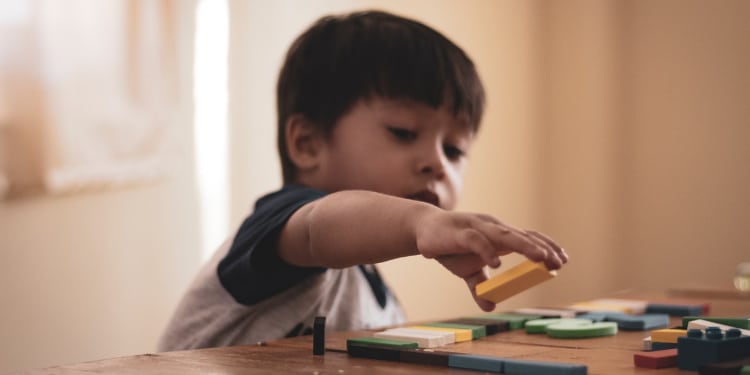











Like adults, young children and adolescents can experience post-traumatic stress disorder, also known as PTSD. After an extremely distressing event or experience, the memory remains to the point of feeling as though it is “stuck” in the mind and body. These persistent memories may lead to varied symptoms that, over time, can manifest into disturbing chronic behaviors and troubling actions. Because EMDR therapy helps the brain “digest” the traumatic event in an effective and safe way, it is proven to be a successful treatment for both young and old trauma survivors.

As one of the most researched psycho therapeutic treatments for PTSD, it might be worth considering if your child is suffering from a painful and persistent memory. Keep reading to learn more about EMDR therapy for children.
Eye Movement Desensitization and Reprocessing (EMDR) is a nontraditional form of psychotherapy. This non-hypnosis, non-drug procedure is used to weaken the effect of negative emotions and rid the invasive ways a painful or upsetting experience overtakes the mind. After an extremely upsetting experience, adults and children may experience:
While children experience PTSD differently and have their own unique symptoms, the undeveloped mind of a child might be the reason why EMDR may be so effective. After a child experiences trauma, they may have trouble sleeping or have reoccurring nightmares. They may show deviant behavior or protest anything that sparks the memory of the traumatic experience.
For example, if a child was in a car accident, they may throw a tantrum every time they are told to get in the car. They may even completely refuse to travel. A therapist trained in EMDR therapy will help your child’s brain breakdown the traumatic memory so it eventually becomes less disturbing and disabling. Before and after every session, the therapist will have your child rate their level of distress.
PTSD symptoms in children can be the result of sexual or psychological abuse, bullying, seeing someone die, or even from experiencing invasive medical procedures. Some traumas in children occur at the hands of a person with malicious intent; others form by the child’s own perception.
Our individual perception of the world shapes our emotional state. Therefore, a child may have stressful memories that adults may see as “no big deal.” Well-meaning parents may use phrases like, “it’s not that bad” and “get over it,” or “he didn’t mean it.” Yet, there is no way for an adult to determine the degree at which the event was traumatic to a child.
Trauma and PTSD can result from a series of events or after just one experience. The trauma may cause the child to believe the world is dangerous and alter their capability to live as they were pre-trauma. The hopelessness, powerlessness, anger, deep sadness, and other emotions may stem from broken trust, death, violence or abuse perpetrated by a beloved caregiver.
The experience may cause a child to be in an endless state of fear, worry, or anxiety. This can inhibit their ability to live a normal life, make friends, and sustain relationships.
Research supports that EMDR is effective for treating children and adolescents with symptoms and behaviors associated with PTSD. These may include guilt, dissociation, attachment issues, anxiety, anger, and depression.
The treatment can be used to boost a child’s self-esteem and confidence. In the last decade, the World Health Organization recommended trauma-focused cognitive behavioral therapy and EMDR as the most effective psychotherapies for children and adolescents with post traumatic stress disorder. Of the two, EMDR has proven to be pointedly more efficient.
The risks involved in any kind of therapy, including EMDR depends on the therapist’s ability and aptitude. It is vital that only a fully trained, licensed therapist administer EMDR therapy to your child. Your child’s EMDR therapist should know how to apply the method to your child’s explicit trauma and developmental needs.
Therapy can be a scary prospect to a child. As a victim of PTSD, their perception of life is already altered and leaving them feeling frightened and anxious about most things. But by helping them understand that their brain is a magnificent thing and the treatment can help them feel better, they may become curious and more eager to accept it.
Before beginning any treatment, the therapist should explain the process to your child in a way he or she will understand. The child’s parents or caregivers should be considered partners in the process and track changes as the child’s treatment progresses.
During the treatment, the therapist trained in EMDR guides the child by encouraging them to concentrate on the troubling memory. At the same time, the child moves their eyes rapidly back and forth as they follow the therapist’s fingers. The rapid eye movement (REM) mimics the natural occurrence that happens when a person is dreaming.

This is the key to helping the child speed through the healing process. Depending on the unique needs of the child, EMDR is often used in conjunction with other therapeutic methods, such as play therapy, music therapy, animal-assisted therapy, yoga therapy, art therapy and sand tray therapy. A multifaceted approach can help keep the child’s interest in therapy while nurturing the healing process.
As indicated, EMDR therapy works very well with children. With less accumulated trauma than adults, children tend to quickly pick up on the process and heal faster. The non-hypnosis psychotherapy procedure and non-drug option is often very appealing to both parents and children.
It is important to remember that a child can be traumatized by any overwhelming experience, not just neglect or abuse. When an event is too much to handle for their internal resources it can lead to trauma. Events that are too hard to process such as humiliation by peers, a bully at school, inconsistent parenting or divorce can create long lasting negative effects.
The depression, low self-esteem and unhappiness from childhood trauma can follow a child into adulthood if left untreated.
If your child has experienced trauma get help immediately. A good place to start is by contacting a licensed therapist. The sooner they get treatment, the better the chances of overcoming the trauma.